Family : Labridae

Text © Giuseppe Mazza

English translation by Mario Beltramini
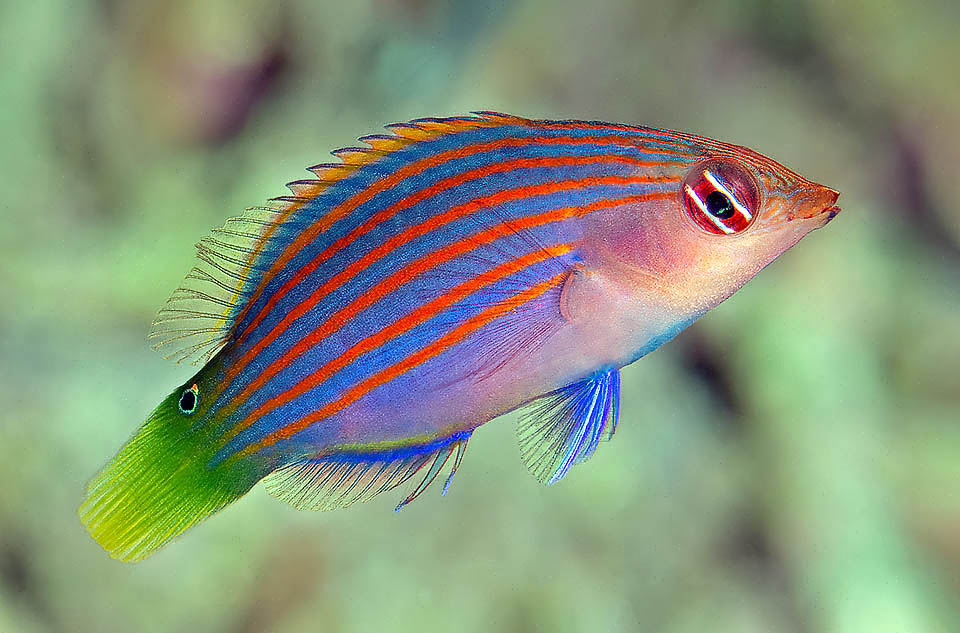
Common in the Indo-Pacific, Pseudocheilinus hexataenia is a palette of colors that rarely reaches 10 cm in length © Belen Caro
Pseudocheilinus hexataenia (Bleeker, 1857), commonly known as Sixline wrasse, belongs to the class of the Actinopterygii, the ray-finned fishes, to the vast order of the Perciformes, and to the numerous family of the Labridae.
The name of the genus Pseudocheilinus, comes from the Greek “ψευδής” (pseudes), false, and “χεῖλος” (cheilos), lips, that is, “false lips”, due to the profile of the muzzle; the specific one, hexataenia, comes, aways in Greek, from “ἑξα-” (hexa-), six, and “ταίνια “(tainia), stripe, due to the presence on its sides of 6 orange lines.
Zoogeography
Pseudocheilinus hexataenia has a very vast distribution in the tropical Indo-Pacific.
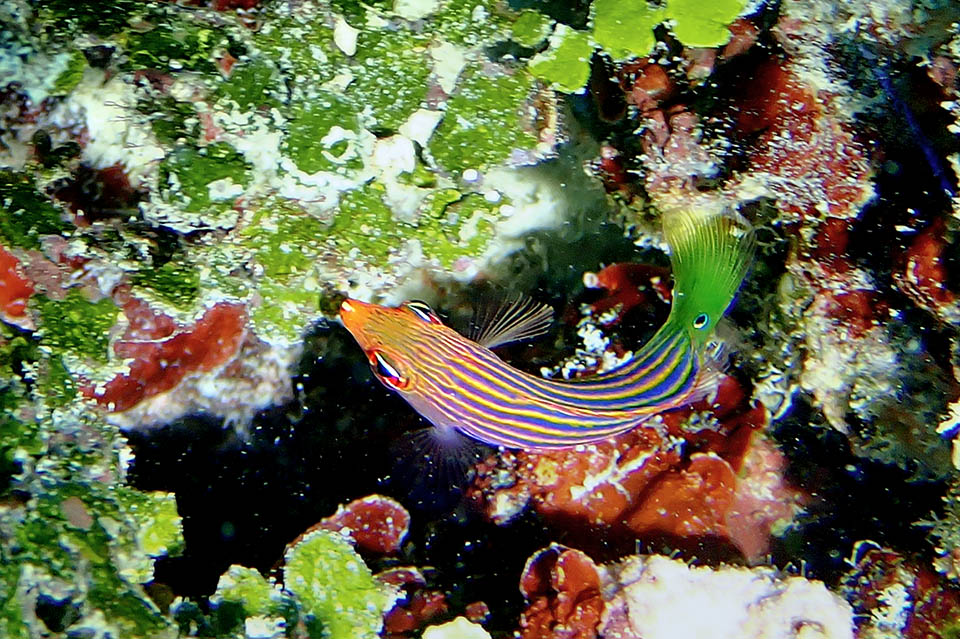
Although it can be found in 1 m of water, it generally swims on the overhangs on the outer side of reefs, at 4-35 m depth with temperatures of 24-28 °C © Debra Baker
We find it from the Red Sea to South Africa along all the African coast and in Madagascar. Then, towards east, is present, indicatively, in the islands of Réunion, Mauritius, Seychelles, Maldives, India, Sri Lanka, Thailand, Malaysia, Indonesia, Vietnam, Philippines, Taiwan and China up to south Japan. Frequent also in Oceania, from Papua New Guinea, the Australian Great Barrier Reef up to Tuamotu Archipelago and Southern Islands.
Ecology-Habitat
Even if it might be seen in 1 m of water, it usually swims on the slopes of the outer side of the reefs at 4-35 m of depth with temperatures of 24-28 °C. It looks for food moving with caution, ready to take shelter among the corals at the first sign of danger.
Morphophysiology
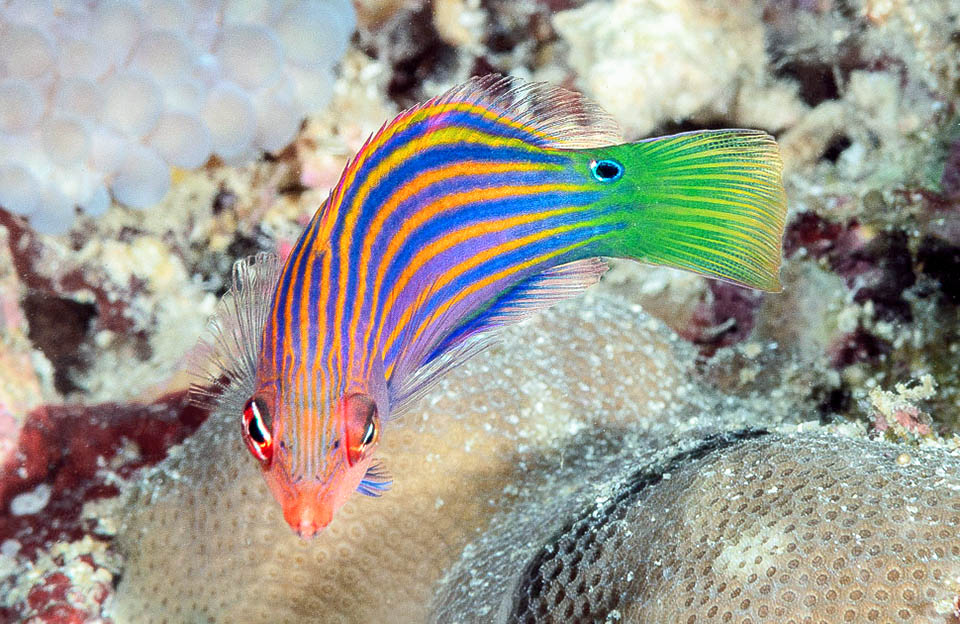
It searches for food by moving cautiously, ready to take refuge among the corals at the first sign of danger © François Libert
It reaches a maximum length of 10 cm, and this, united with the multicoloured livery and a more than affordable price, renders it one of the frequent hosts for marine and domestic aquaria. The six orange bands are emphasized by the adjacent blue starting from the lower part of the dorsal fin and accompanies them up to the belly where it turns pink, the same colour as the head, adorned by blue arabesques and a fine red dotting on the chin sided, as if it was not enough, by an analogous yellow dotting. Peduncle and most of the caudal fin are green with a very small ocellus, whilst the eye is red with two parallel white bands to confuse the ideas to the predators.
The dorsal fin has 9 spiny rays and 11-12 soft. The anal fin, also blue at the base, counts 3 spiny rays and 9 unarmed. The translucent pectorals and the pelvic with blue strokes have only unarmed rays.
There is no sexual dimorphism but the females are smaller and rarely exceed the 7 cm.
Ethology-Reproductive Biology
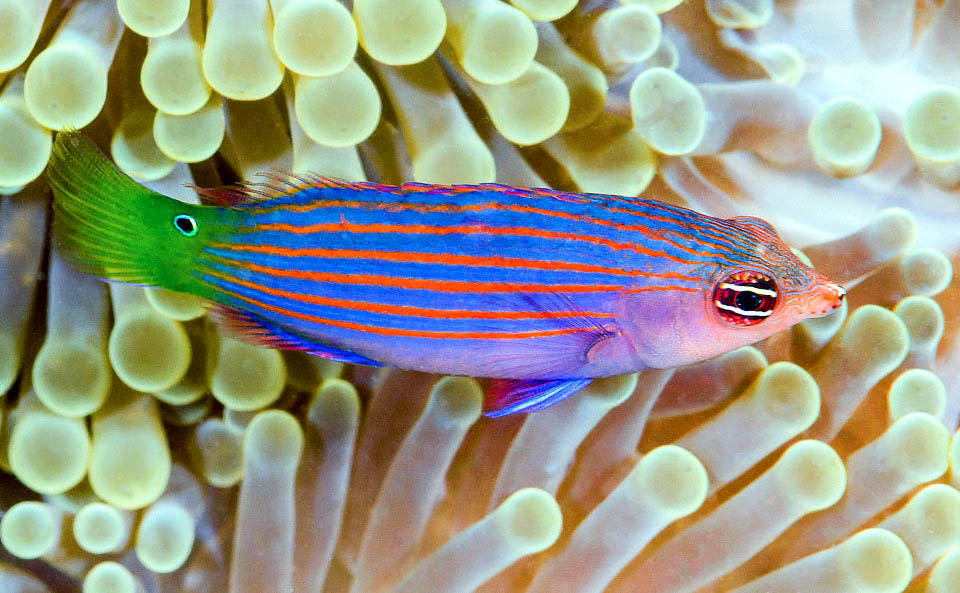
It feeds on zooplankton but also on small crustaceans, amphipods, lobster larvae, small worms and eggs stolen from fish that lay their eggs among algae or under corals © François Libert
The Sixline wrasse nourishes of zoo-plankton but also of zoobenthos, that is of the animals it finds on the bottom. In its diet enter regularly crustaceans, amphipods, larvae of lobster, small worms and the eggs regularly stolen to the fishes that lay them among the algae or under the corals.
It may lead a solitary life, in couple or in small harems with the male that approaches the female on duty ready to lay. There are no, as at time happens in the reefs, group weddings. The parental cares are absent and after the fecundation the eggs are abandoned to their fate.
Pseudocheilinus hexataenia is a very territorial animal and this trend manifests at once in aquarium with fierce attacks against the newcomers, even if bigger.
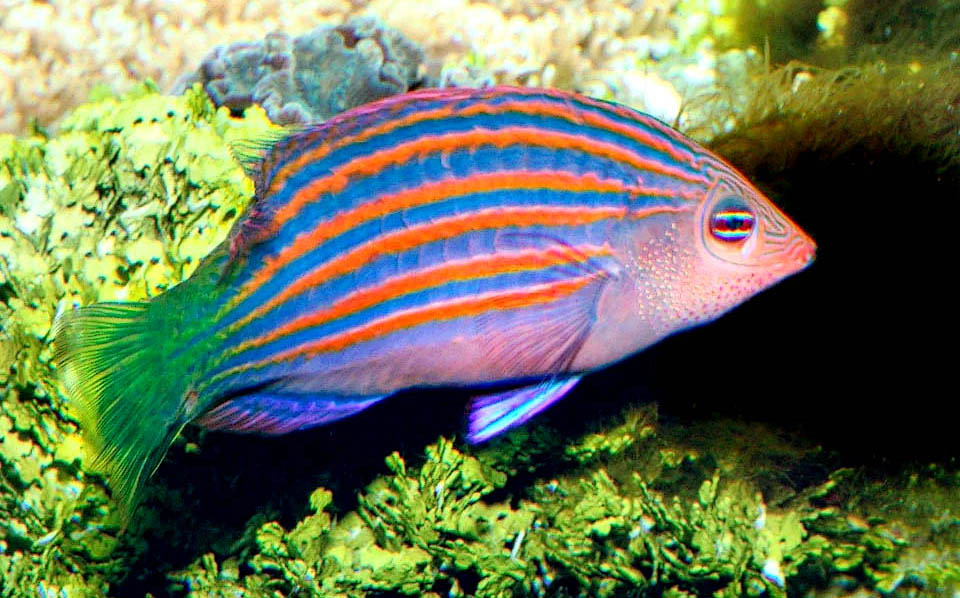
It is among the most common marine aquarium fish. It adapts but has never reproduced and is left open the lid often jumps out, hoping to fall into a better world © Giuseppe Mazza
For the rest, they are not difficult fishes: they eat prawns of the genera Mysis, Artemia, Cyclops, possibly alive in the first days, then also frozen, to reach, if they accept them, the micro-granules for marine fishes. They have never reproduced in aquarium, clear sign that they are not happy. So much so that if they leave open the cover of the aquarium they often jump outside, hoping to fall in a better world.
Resilience is excellent with the population doubling in less than 15 months and the index of vulnerability to fishing, very low, marks just 10 on a scale of 100.
Since 2009 Pseudocheilinus hexataenia has therefore been listed as “LC, Least Concern” in the IUCN Red List of endangered species.
Synonyms
Cheilinus hexataenia Bleeker, 1857; Pseudolabrus hexataenia (Bleeker, 1857); Pseudocheilinus psittaculus Kner & Steindachner, 1867; Cossyphus echis Guichenot, 1869.
→ For general information about FISH please click here.
→ For general information about BONY FISH please click here
→ For general information about CARTILAGINOUS FISH please click here.
→ To appreciate the BIODIVERSITY of BONY FISH please click here.
→ To appreciate the BIODIVERSITY of CARTILAGINOUS FISH please click here.
